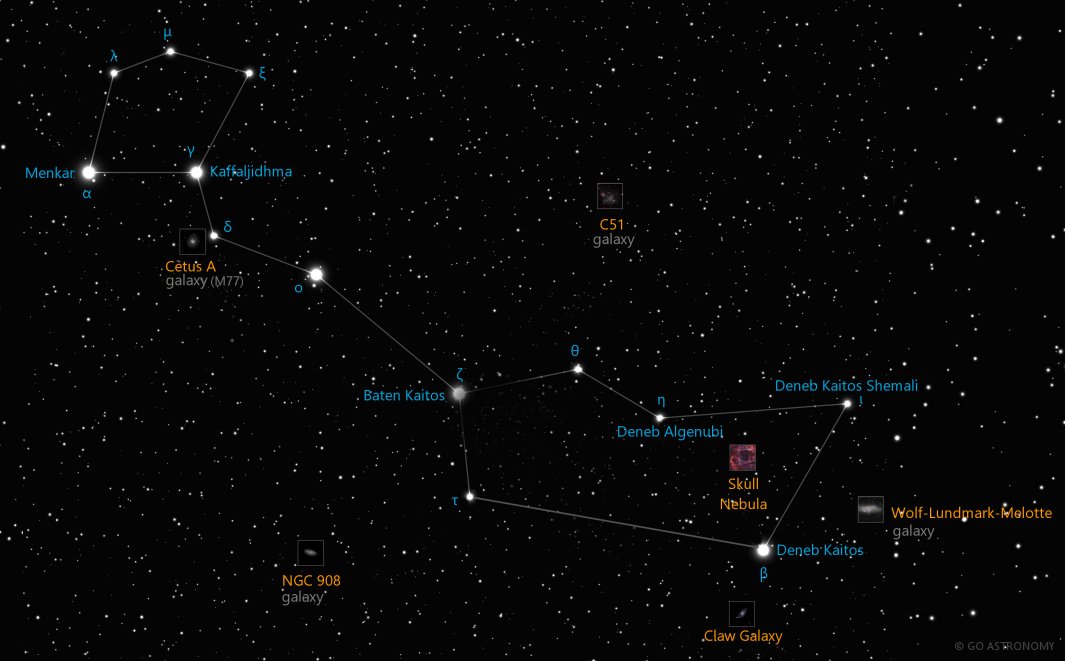Cetus, the Whale (Cet)
(SEE-tus)
The Southern constellation of Cetus, the Whale, is best viewed in Winter during the month of December.
Cetus is the 4th largest constellation. It's brightest star is Deneb Kaitos at magnitude 2.04. The boundary of the Cetus constellation contains 36 stars that host known exoplanets.
Cetus is an equatorial constellation, which means its bulk intersects the celestial equator or comes within 10-15 degrees of doing so. Cetus is visible from most places on Earth.
- Pronunciation:
- SEE-tus
- Meaning:
- Whale
- Genitive:
- Ceti
- Abbreviation:
- Cet
- Constellation Family:
- Perseus
- Hemisphere:
- Southern
- Quadrant:
- SQ1
- Visibility:
- 70° N - 90° S
- Best viewing month*:
- December
- Area:
- 1231 sq. degrees
- Size:
- 4th largest
- Equatorial:
- Yes
- Right Ascension (avg):
- 1h 43m
- Declination (avg):
- -8°
- Brightest star:
- Deneb Kaitos (2.04)
- Stars with planets:
- 36
Brightest Stars in Cetus
The 10 brightest stars in the constellation Cetus by magnitude.
- Star
- Magnitude
- Spectral class
- Beta Ceti (β Cet)
- 2.04
- K0III
- Alpha Ceti (α Cet)
- 2.54
- M2III
- Omicron Ceti (ο Cet)
- 3.04
- M5e-M9e
- Eta Ceti (η Cet)
- 3.46
- K2III
- Gamma Ceti (γ Cet)
- 3.47
- A3V
- Tau Ceti (τ Cet)
- 3.49
- G8V
- Iota Ceti (ι Cet)
- 3.56
- K2III
- Theta Ceti (θ Cet)
- 3.6
- K0III
- Zeta Ceti (ζ Cet)
- 3.74
- K2III
- Upsilon Ceti (υ Cet)
- 3.99
- K5/M0III
Double Stars in Cetus
These are the brightest and easiest-to-find double, triple, and quadruple star systems in the constellation Cetus. Also see all star clusters.
- Star system
- Magnitudes
- Type
- Gamma Ceti
- 3.5, 6.2
- double
Nebulae in Cetus
Notable and easy-to-find nebulae in the constellation Cetus . Also see all nebulae.
Galaxies in Cetus
The most notable galaxies in the constellation Cetus. Also see all galaxies.
- Name
- Alt name
- Type
- Cetus A
- M77
- spiral
- Minkowski's Object
- lenticular
- Wolf-Lundmark-Melotte
- irregular
- Arp 147
- galaxy pair
- Arp 256
- galaxy pair
- Caldwell 51
- C51
- irregular
- Claw Galaxy
- C62
- spiral
- Holmberg 15A
- elliptical
- NGC 274/275
- galaxy pair
- NGC 545/547
- galaxy pair
Milky Way Satellites in Cetus
Dwarf satellite galaxies that orbit the Milky Way Galaxy located in the constellation Cetus. Also see all Milky Way satellite galaxies.
- Galaxy name
- Alt name
- Magnitude
- Cetus III
- Cetus II
The Sea Monster of the Cosmos
Cetus is a constellation in the southern sky named after a sea monster in Greek mythology, often referred to as 'the whale' in modern times. It is among the 88 constellations officially recognized by the International Astronomical Union (IAU), and hosts a wealth of celestial objects that are fascinating to both professional astronomers and amateur stargazers.
Historical Overview
Cetus is one of the 48 constellations listed by the 2nd-century astronomer Ptolemy, and it remains one of the 88 modern constellations. It represents the sea monster (or whale) that was to devour Andromeda, who was chained to a rock as a sacrifice. The hero Perseus rescued Andromeda, and both of them, along with Cassiopeia and Cepheus, Andromeda's parents, are commemorated as constellations in the northern sky.
Location and Notable Features
The constellation Cetus is located in the first quadrant of the southern hemisphere (SQ1) and can be seen at latitudes between +70? and -90?. It is surrounded by several constellations including Aries, Aquarius, Eridanus, Fornax, Pisces, Sculptor, and Taurus.
The brightest star in Cetus is Diphda (Beta Ceti), an orange giant situated approximately 96 light years away from Earth. It is the 10th brightest star in the night sky and is sometimes called Deneb Kaitos, meaning the "tail of the whale".
Deep Sky Objects
Cetus hosts several fascinating deep-sky objects. The constellation contains the notable barred spiral galaxy Messier 77 (also known as Cetus A), which is one of the brightest galaxies in the sky and is a popular target for both professional astronomers and backyard observers. It is located approximately 47 million light-years away.
Additionally, Cetus contains the famous redshift 1.9 quasar PKS 0133-176, which is one of the most distant objects visible from Earth, lying billions of light years away. Cetus is also home to the Cetus Dwarf galaxy, a small elliptical galaxy that is a satellite of the Milky Way.
Observing Cetus
As a southern sky constellation, Cetus is best observed during the months of November and December, when it reaches its highest point in the night sky. However, it is visible from most locations on Earth, except for the far northern latitudes.
The constellation's shape is often compared to a parallelogram, which makes it somewhat easier to identify. Diphda, the brightest star in Cetus, can be located by following a line southward from the stars of Aries.
For observers interested in deep-sky objects, a small to medium-sized telescope is recommended. Such equipment will reveal the bright core of Messier 77 and may even allow glimpses of its spiral arms. The Cetus Dwarf galaxy, however, is too faint to be observed with amateur equipment.
* Constellation shown for northen hemisphere skies. For the southern hemisphere, constellations appear rotated 180 degrees (upside-down and left-right reversed) from what is shown. Remember that seasons are reversed too - summer in northern latitudes is winter in southern latitudes.
** Circumpolar constellations are visible year-round in the hemisphere listed (and not at all in the opposite hemisphere).





